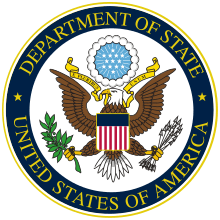John Moore Allison
John Moore Allison (April 7, 1905 – October 28, 1978) was a US diplomat most commonly known for being US Ambassador to Japan from 1953 to 1957. From 1957 to 1958 he was Ambassador to Indonesia and from 1958 to 1960 to Czechoslovakia. In the 1960s and 1970s he was Professor at the University of Hawaii. In 1973 he published his memoir, Ambassador from the Prairie.[1]
Allison first visited Japan in 1927, following his graduation from the University of Nebraska. He worked for two years as an English teacher in Odawara and Atsugi before joining the State Department in 1930. He studied Japanese in Tokyo and then worked in the foreign service in Japan and China, serving as consul in Dalian (1935–36), Jinan (1936–37), Nanjing (1937–38), Shanghai (1938), and Osaka (1939–41).
On January 26, 1938, during the period of the Nanking Massacre, John M. Allison, at the time consul at the American embassy in Nanjing, was struck in the face by a Japanese soldier.[2][3] This incident is commonly known as the Allison incident. Japanese Consul-General Katsuo Okazaki "apologized formally on January 30[4] (after the Americans demanded they do so). This incident, together with the looting of American property in Nanking that took place at the same time, further strained relations between Japan and the United States, which had already been damaged by the Panay incident less than two months earlier."[5]
Allison served as a consul in London during World War II. After Japan's surrender, he served in various State Department leadership positions covering Japan and the Far East from 1946 to 1952. Allison participated in the drafting of the Treaty of San Francisco that formally ended the war, serving as John Foster Dulles's aide during the latter's negotiation of the treaty.[6]
Allison was named United States Ambassador to Japan in 1953. In 1954, 16 years after the "Allison Incident," Allison and the man who had apologized to him in Nanjing, Japanese Foreign Minister Okazaki, signed the U.S. and Japan Mutual Defense Assistance Agreement on behalf of their respective countries.[7]
In 1957, during his ambassadorship to Indonesia, he recommended the U.S. government mediate on the Western New Guinea issue.[8][9]
References
- Allison, John M. (1973). Ambassador from the Prairie or Allison in Wonderland. Houghton Mifflin. ISBN 0-395-17205-5.
- Abend, H. "Diplomat Slapped By Tokyo Soldier". The New York Times 1938 article. Full-length article here. (login required)
- "1938: Japan". MSN Encarta. Full-length article here. Archived 2009-10-31.
- They Were in Nanjing: The Nanjing Massacre Witnessed by American and British, p216
- Museum, The Bay (2019-11-15). "THE INTER-WAR PERIOD 1938". The Bay Museum. Retrieved 2020-02-02.
- "Challener Interview with John M. Allison" (PDF). Princeton Seeley G. Mudd Library. Retrieved 13 August 2018.
- "U.S. and Japan Mutual Defense Assistance Agreement". Archived from the original on 2008-11-22. Retrieved 2015-05-13.
- Friend, T. (2003). Indonesian Destinies. Harvard University Press. pp. 116. ISBN 0-674-01137-6.
- "U. S. To Transfer Envoy In Jakarta". The New York Times 1958 article. Full-length article here. (login required)
| Government offices | ||
|---|---|---|
| Preceded by Dean Rusk |
Assistant Secretary of State for Far Eastern Affairs February 1, 1952 – April 7, 1953 |
Succeeded by Walter S. Robertson |
| Diplomatic posts | ||
| Preceded by Robert Daniel Murphy |
United States Ambassador to Japan May 28, 1953 – February 2, 1957 |
Succeeded by Douglas MacArthur II |
| Preceded by Hugh S. Cumming, Jr. |
United States Ambassador to Indonesia March 13, 1957 – January 29, 1958 |
Succeeded by Howard P. Jones |
| Preceded by U. Alexis Johnson |
United States Ambassador to Czechoslovakia April 24, 1958 – May 4, 1960 |
Succeeded by Christian M. Ravndal |
